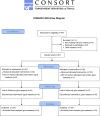A Comparison of the Clinical Effectiveness Between Low-Dose Strong Opioids and Non-Steroidal Anti-Inflammatory Drugs in the Treatment of Mild Cancer Pain: A Randomized Trial
- PMID: 34754234
- PMCID: PMC8570376
- DOI: 10.2147/JPR.S322893
A Comparison of the Clinical Effectiveness Between Low-Dose Strong Opioids and Non-Steroidal Anti-Inflammatory Drugs in the Treatment of Mild Cancer Pain: A Randomized Trial
Abstract
Objective: The present study aims to explore the effectiveness and safety of low-dose strong opioids compared with non-steroidal anti-inflammatory drugs (NSAIDs) in the treatment of mild cancer pain.
Methods: From September 2016 to September 2018, 66 patients with a malignant tumor and mild cancer pain admitted to the Department of Oncology of Dalian Fifth People's Hospital were divided into the group A (treated with ibuprofen sustained-release tablets for pain relief) and the group B (treated with oxycodone hydrochloride sustained-release tablets for pain relief). After 7 days of treatment, the pain relief (Numeric Rating Scale [NRS]), physical strength, quality of life scores (Zubrod/ECOG/WHO [ZPS]), the Edmonton Symptom Assessment System [ESAS], and the European Organization for Research and Treatment of Cancer Quality of Life Questionnaire-Core15-Palliative [EORTC QLQ-C15-PAL] scores), and the occurrence of adverse reactions between the two groups were compared. The occurrence of adverse reactions in the mid-term (after one month and three months of treatment) between the two groups were also compared.
Results: Both groups had over 90% analgesic efficiency, but complete pain relief was more likely to be obtained in the group B (41.18%). The total analgesic efficiency in the group B was higher (100%) than in the group A (98.9%), and the difference was statistically significant (P < 0.05). The differences in the physical strength and quality of life scores in the two groups before and after treatment were statistically significant (P < 0.05). The differences in the ZPS scores between the two groups were statistically significant (P < 0.05). The differences in ESAS and EORTC QLQ-C15-PAL scores between groups were not statistically significant (P > 0.05).
Conclusion: The application of low-dose oxycodone hydrochloride sustained-release tablets as the initial medication for patients with mild cancer pain was safe and effective, and the adverse reactions were easy to manage.
Keywords: clinical effect; mild cancer pain; non-steroidal anti-inflammatory drugs; oxycodone hydrochloride sustained-release tablet.
© 2021 Liu et al.
Conflict of interest statement
The authors report no conflicts of interest in this work.
References
-
- Cleary J, Silbermann M, Scholten W, Radbruch L, Torode J, Cherny NI Formulary availability and regulatory barriers to accessibility of opioids for cancer pain in the Middle East: a report from the Global Opioid Policy Initiative (GOPI). Ann Oncol. 2013;24 Suppl 11:xi51–9. - PubMed
LinkOut - more resources
Full Text Sources


